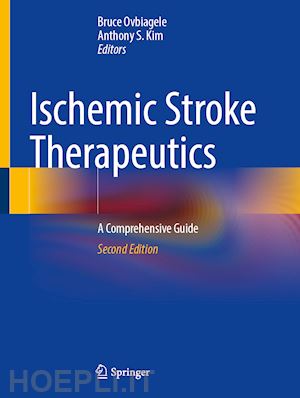
Questo prodotto usufruisce delle SPEDIZIONI GRATIS
selezionando l'opzione Corriere Veloce in fase di ordine.
Pagabile anche con Carta della cultura giovani e del merito, 18App Bonus Cultura e Carta del Docente
This second edition updates established evidence for contemporary management of ischemic stroke. Therapeutics for acute management, secondary prevention, recovery, rehabilitation, asymptomatic cerebral ischemia, special populations, and implementation of stroke systems of care are all discussed.
Chapters are authored by leading academicians from around the world with real-world clinical practice experience, and comprise the scientific rationale and expert consensus recommendations, which underlie prevailing (and possibly future) therapeutic strategies for managing ischemic cerebrovascular disease. New chapter topics include neuroprotectants, treatment of the oldest old, brain-computer interfaces, disparities, and the global burden.
The specialist or general practitioner will gain critical knowledge in stroke management, current clinical challenges and promising new therapies under investigation.
Section 1-ACUTE THERAPEUTICS.- Chapter 1:Prehospital Stroke Treatment (EMS Stabilization Protocols).- Chapter 2.- Neuroprotectants.- Chapter 3.- Acute blood pressure management.- Chapter 4.- Intravenous Thrombolysis.- Chapter 5.- Endovascular Therapy for Acute Ischemic Stroke.- Chapter 6: Advanced Imaging for Extended-Window Therapy.- Chapter 7: Acute Antithrombotic Therapy.- Chapter 8: Decompressive Hemicraniectomy and Suboccipital Craniectomy for Acute Ischemic Stroke.- Chapter 9: Supportive Care and Management of Inhospital Complications.- Chapter 10: Post-discharge Complications of Stroke.- Section 2: PRIMARY PREVENTION THERAPEUTICS.- Chapter 11: TAILORED APPROACH TO SECONDARY PREVENTION AFTER STROKE.- Chapter 12: Antithrombotics Therapy For Heterogeneous Causes Of Stroke.- Chapter 13: Management of Emerging or Unconventional Risk Factors.- Chapter 14: Management of Emerging or Unconventional Risk Factors-2.- Chapter 15: Asymptomatic Carotid Artery Stenosis.- Section 3: SECONDARY PREVENTION THERAPEUTICS.- Chapter 16: Subclinical Vascular Brain Injury.- Chapter 17: Secondary Prevention After Cardioembolic Stroke.- Chapter 18: SECONDARY PREVENTION OF Lacunar Stroke.- Chapter 19: Symptomatic Extracranial Large Artery Disease.- Chapter 20: Symptomatic Intracranial Atherosclerotic Disease.- Chapter 21: Non-atherosclerotic Cerebral Vasculopathies.- Section 4: REHABILITATION AND RECOVERY.- Chapter 22: Botulinum Toxin for Post-stroke Limb Spasticity.- Chapter 23: Selective Serotonin Reuptake Inhibitors.- Chapter 24: Constraint-Induced Therapies.- Chapter 25: Virtual Reality for Motor Recovery in Stroke Rehabilitation.- Chapter 26: Transcranial Magnetic Stimulation.- Chapter 27: Brain Computer Interfaces for Rehabilitation after Stroke.- Section 5: SPECIAL POPULATIONS.- Chapter 28: Pediatric Stroke.- Chapter 29: Oldest Old.- Chapter 30: Vascular Cognitive Impairment.- Section 6: SYSTEMS OF CARE.- Chapter 31: Stroke Systems of Care and Stroke Centers.- Chapter 32: Telemedicine in Stroke Systems of Care.- Chapter 33.- Broadly Bridging the Breach: Stroke Disparities.- Chapter 34.- The Role of Registries and Community-based Databanks in Developed Countries.- Chapter 35: Systematically Addressing Stroke Burden in the Developing World - A FRAMEWORK FOR EFFECTIVE IMPLEMENTATION
Bruce Ovbiagele, MD, MSc, MAS, MBA, MLS
Professor of Neurology and Associate Dean
University of California, San Francisco
San Francisco, CA
Anthony S. Kim, MD, MAS
Professor of Neurology; Erich Fried Endowed Professor of Vascular Neuroscience; and Medical Director, UCSF Comprehensive Stroke Center
University of California, San Francisco
San Francisco, CA











Il sito utilizza cookie ed altri strumenti di tracciamento che raccolgono informazioni dal dispositivo dell’utente. Oltre ai cookie tecnici ed analitici aggregati, strettamente necessari per il funzionamento di questo sito web, previo consenso dell’utente possono essere installati cookie di profilazione e marketing e cookie dei social media. Cliccando su “Accetto tutti i cookie” saranno attivate tutte le categorie di cookie. Per accettare solo deterninate categorie di cookie, cliccare invece su “Impostazioni cookie”. Chiudendo il banner o continuando a navigare saranno installati solo cookie tecnici. Per maggiori dettagli, consultare la Cookie Policy.